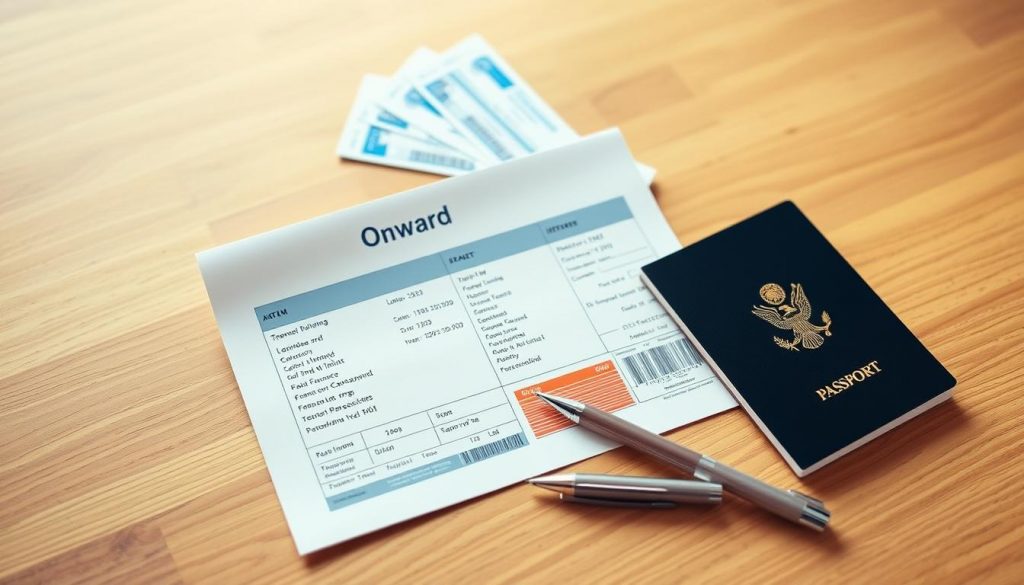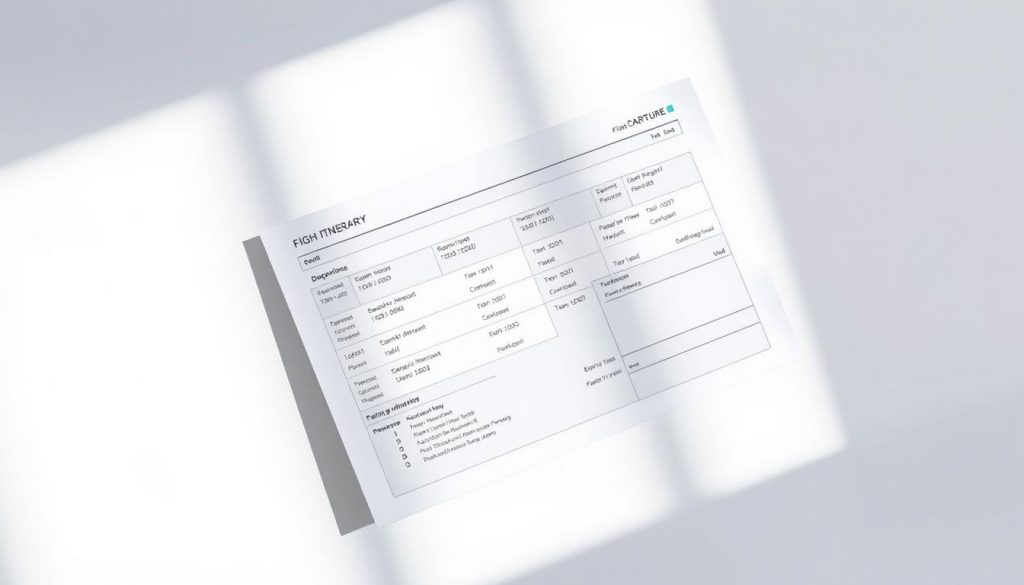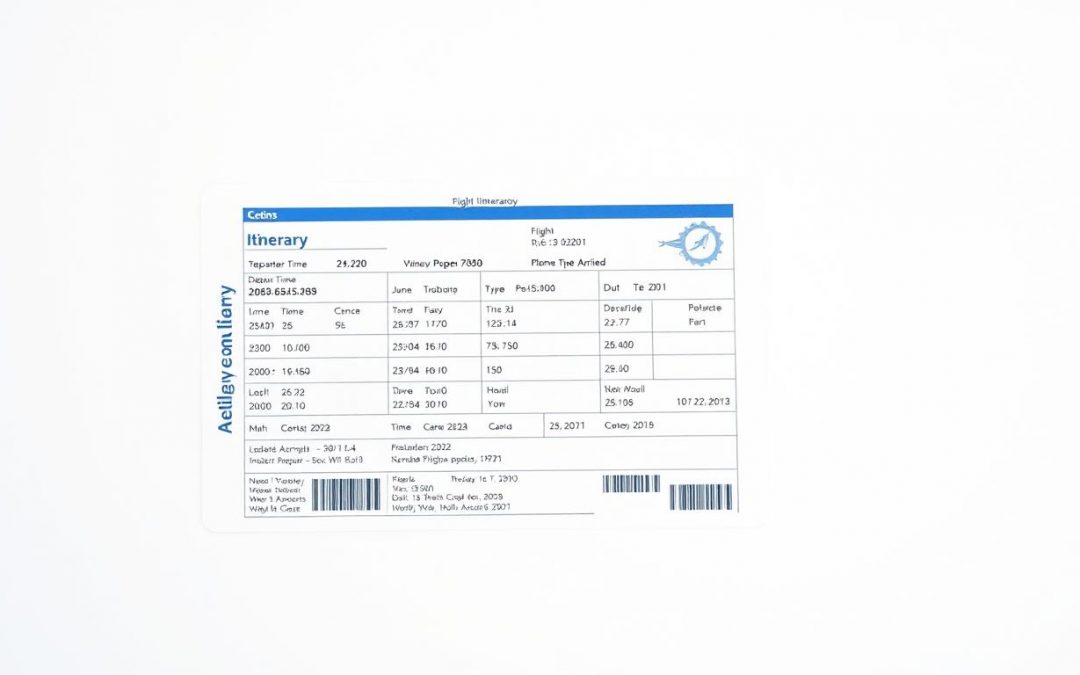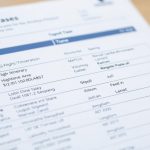A well-crafted flight itinerary is crucial for a successful visa application. It serves as proof of travel plans, demonstrating to visa authorities that you intend to leave the country. Our guide will walk you through creating a compliant flight itinerary that meets the requirements.
Key Takeaways
- A flight itinerary is a required document for most visa applications.
- It’s essential to create a realistic and visa-friendly itinerary.
- Our service provides fast, affordable, and adjustable flight itineraries.
- A well-crafted itinerary can improve your chances of visa approval.
- Adjustments to your itinerary can be made free of charge.
What Is a Flight Itinerary for Visa Applications?
A flight itinerary is a document that outlines your travel plans, serving as a vital component in the visa application process. It provides essential information about your flight, including departure and arrival dates, flight numbers, and sometimes even accommodation details.
Definition and Purpose
The primary purpose of a flight itinerary is to serve as proof of your intention to travel to a specific destination. It is a required document for many visa applications, helping embassies and consulates assess the legitimacy of your travel plans. A valid flight itinerary typically includes your personal details, flight information, and sometimes a booking reference number.
Difference Between Actual Tickets and Visa Itineraries
It’s essential to understand that a flight itinerary is not the same as an actual flight ticket. While an actual ticket confirms your travel arrangements and requires payment, a flight itinerary is often a reservation or a hold on a ticket that can be canceled or modified. Visa itineraries are used specifically for visa applications and may not necessarily result in actual travel. The key difference lies in their purpose: one is for travel confirmation, and the other is for visa application support.
Why Embassies Require Flight Itineraries
Embassies worldwide require flight itineraries as a crucial document for visa applications. This requirement is rooted in the need to verify the authenticity of an applicant’s travel plans.
The primary reason behind this requirement is to ensure that applicants have a genuine intention to travel to the destination country. This is where the concept of proof of travel intent comes into play.
Proof of Travel Intent
A flight itinerary serves as a tangible proof of an applicant’s travel plans, demonstrating their intention to enter and stay in the country for a specified period. It helps embassies assess the applicant’s credibility and genuine travel purpose.
Immigration Control Measures
Embassies also use flight itineraries as part of their immigration control measures. By requiring applicants to provide flight details, they can better monitor and manage the flow of travelers, ensuring compliance with visa regulations and reducing the risk of overstaying.
Some key reasons for requiring flight itineraries include:
- Verifying the applicant’s travel plans
- Assessing the applicant’s financial capability
- Ensuring compliance with visa regulations
Types of Flight Itinerary for Visa Acceptance
Flight itineraries for visa applications come in various forms, each with its own advantages. Understanding these different types can help you choose the best option for your needs.
Confirmed Reservations
A confirmed reservation is a booking that has been made with an airline or travel agency, where the flight details are confirmed, but the payment might not have been made yet. This type of itinerary is often considered reliable because it shows a clear intent to travel.
Verifiable Bookings
Verifiable bookings are reservations that can be checked with the airline or travel agency to confirm their authenticity. This type provides assurance to visa officers that the applicant has made a genuine booking.
Temporary Holds
Temporary holds on flights are another option, where a seat is held for a short period, usually 24 hours, without finalizing the booking. This can be a riskier option but is sometimes used to demonstrate intent to travel.
By understanding the different types of flight itineraries, you can make an informed decision that suits your visa application needs. Each type has its pros and cons, and choosing the right one can improve your chances of visa approval.
Official Methods to Obtain a Flight Itinerary
When applying for a visa, it’s essential to understand how to obtain a legitimate flight itinerary. A flight itinerary serves as proof of travel plans, and visa authorities require it to process applications. There are two primary official methods to obtain a flight itinerary: through airlines directly and via travel agencies.
Through Airlines Directly
One of the most straightforward ways to obtain a flight itinerary is by contacting airlines directly. Most airlines offer the option to book a flight and receive a confirmed itinerary without immediate payment. This can be done through their official websites or by visiting their customer service desks at the airport. For instance, airlines like Lufthansa and Emirates provide this service, allowing travelers to reserve a seat and receive an itinerary that can be used for visa applications.
Via Travel Agencies
Another official method is to use travel agencies that are authorized by airlines to issue flight itineraries. Travel agencies like Expedia and Kayak often have agreements with multiple airlines, enabling them to provide a wide range of flight options. By using a travel agency, applicants can get assistance in selecting the appropriate flights and obtaining the necessary documentation for their visa application. It’s crucial to ensure that the travel agency is reputable and recognized by the relevant visa authorities.
Creating a Flight Reservation Without Payment
For visa applicants, creating a flight reservation without immediate payment can be a strategic move. This approach allows travelers to fulfill visa requirements without incurring the costs associated with booking a flight ticket outright.
Airline Hold Options
One method to achieve a flight reservation without payment is by utilizing airline hold options. Many airlines offer the ability to hold a booking for a certain period, typically 24 hours, without requiring payment. This can be a useful strategy for visa applicants who need to demonstrate their travel plans without committing to a flight.
For instance, some airlines provide a “hold” or “reserve” option on their websites, allowing passengers to reserve a seat on a flight for a limited time. During this period, the booking is considered valid for visa purposes, even though the ticket has not been paid for.
24-Hour Cancellation Policies
Another strategy is to take advantage of 24-hour cancellation policies offered by many airlines. By booking a flight and then canceling it within 24 hours, travelers can obtain a valid reservation without ultimately paying for the ticket. It’s essential to review the airline’s cancellation policy to ensure compliance with their rules.
It’s worth noting that some airlines may still require payment information to secure the booking, even if it’s cancelable within 24 hours. Travelers should be aware of any potential fees or charges associated with canceling a booking.
Risk Assessment
While creating a flight reservation without payment can be beneficial for visa applicants, it’s crucial to assess the risks involved. Misrepresenting travel plans or attempting to deceive visa officers can lead to severe consequences, including visa rejection or even bans on future applications.
| Method | Risks | Benefits |
|---|---|---|
| Airline Hold Options | Limited hold period, potential fees | No upfront payment, valid for visa |
| 24-Hour Cancellation | Requires initial payment, potential cancellation fees | Valid reservation, flexibility to cancel |
By understanding the available options and their associated risks, travelers can make informed decisions about creating a flight reservation without payment, ultimately enhancing their visa application.
Onward Ticket Requirements and Solutions
Meeting onward ticket requirements is essential for visa approval, and there are various strategies to achieve this. Understanding the rules and regulations surrounding onward travel is crucial for a successful visa application.
Understanding Onward Travel Rules
Onward travel rules vary by country, but most require proof of onward or return travel as a condition for visa issuance. This rule is in place to ensure that visitors do not overstay their visas. It’s essential to check the specific requirements for the country you plan to visit.
Some countries have strict requirements, while others are more lenient. For instance, some may require a confirmed onward ticket, while others may accept a reservation or a proof of onward travel booking.
Strategies for Meeting Requirements
Several strategies can help meet onward ticket requirements. One option is to book a fully refundable ticket, which can be canceled later if needed. Another is to use services like Flyonward, which provide temporary onward travel solutions. It’s also advisable to research the visa requirements well in advance to plan accordingly.

By understanding the onward travel rules and employing the right strategies, visa applicants can improve their chances of a successful application.
Online Services for Flight Itinerary Generation
Online services have revolutionized the way we generate flight itineraries for visa applications, making it a hassle-free process. With numerous platforms available, individuals can now easily create the necessary documents for their visa applications without the need for actual flight bookings.
Legitimate Reservation Services
Legitimate reservation services provide a reliable way to obtain a flight itinerary. These services partner with airlines to offer confirmed reservations that are verifiable by embassies. Reliability is key when selecting such services, as the generated itinerary must be acceptable to visa authorities.
Comparing Flyonward and Similar Services
Flyonward is a well-known service for generating flight itineraries, but it’s not the only option. When comparing Flyonward with similar services, factors such as cost, reliability, and customer support should be considered. Other services may offer more competitive pricing or better support, making it essential to research and compare before making a decision.
Flight Itinerary Generator Tools
Flight itinerary generator tools are another convenient option for creating visa-ready itineraries. These tools often provide a user-friendly interface where you can input your travel details and generate an itinerary. When using these tools, ensure they produce itineraries that are verifiable and comply with the requirements of the embassy or consulate you’re dealing with.
Some tools also offer additional features such as customization options and real-time updates, enhancing their utility for visa applications.
Step-by-Step Guide to Creating a Visa-Ready Flight Itinerary
Crafting a visa-ready flight itinerary is a crucial step in the visa application process. It requires attention to detail and a thorough understanding of the requirements. In this section, we will provide a step-by-step guide on how to create a compliant flight itinerary.
Selecting Appropriate Dates
When selecting dates for your flight itinerary, it’s essential to ensure they align with your travel plans and visa application. Choose dates that are realistic and comply with the visa requirements. For instance, if you’re applying for a visa, your flight dates should not be before the visa’s intended start date.
Choosing Realistic Routes
Choosing realistic routes is another critical aspect of creating a visa-ready flight itinerary. Your route should be logical and consistent with your travel plans. For example, if you’re traveling to the United States, your flight itinerary should reflect a plausible route, including any layovers or connections.
Including Required Information
Including required information is vital to ensure your flight itinerary is visa-ready. This typically includes your full name, flight numbers, departure and arrival airports, dates, and any other relevant details. Make sure this information is accurate and matches your visa application.
By following these steps and paying close attention to the details, you can create a visa-ready flight itinerary that enhances your visa application. Remember, the goal is to provide a document that is both compliant with visa requirements and reflective of your genuine travel plans.
Common Mistakes to Avoid in Your Flight Itinerary
When applying for a visa, a well-crafted flight itinerary is crucial, but common mistakes can lead to rejection. A flight itinerary that contains errors or unrealistic information can raise red flags with visa officers, potentially jeopardizing your application.
Unrealistic Travel Dates
One of the most common mistakes is selecting unrealistic travel dates. Ensure that your travel dates align with your visa application and are feasible based on your circumstances. Avoid choosing dates that are too soon or too late for your intended travel period.
Incorrect Personal Information
Incorrect personal information is another critical error. Verify that your name, passport number, and other details match your passport and visa application exactly. Inconsistencies can lead to immediate rejection.
Missing Essential Details
Missing essential details, such as flight numbers, departure and arrival times, or airline information, can also cause issues.

Ensure your itinerary is complete and includes all necessary information to avoid raising suspicions.
By avoiding these common mistakes, you can significantly improve the chances of your visa application being approved.
Legal Considerations and Ethical Boundaries
Navigating the visa application process requires awareness of both legal requirements and ethical considerations. When creating a flight itinerary for visa purposes, it’s essential to understand the fine line between complying with visa requirements and committing fraud.
Understanding Visa Requirements vs. Fraud
Visa requirements are in place to ensure that travelers provide accurate information about their trip. Fraud occurs when an applicant intentionally misrepresents information, such as providing a fake flight itinerary. It’s crucial to differentiate between meeting visa requirements and misrepresenting information.
For instance, some countries require a confirmed flight itinerary as part of the visa application process. Providing a genuine, albeit temporary, flight reservation is acceptable, whereas submitting a completely fabricated itinerary is considered fraudulent.
Potential Consequences of Misrepresentation
Misrepresenting information on a visa application can have severe consequences. These can include visa rejection, bans on future applications, and even legal action. It’s vital to understand that visa officers verify the information provided, and discrepancies can lead to serious repercussions.
| Action | Consequence |
|---|---|
| Providing a genuine flight reservation | Visa application processed normally |
| Misrepresenting flight information | Visa rejection, potential ban |
By being aware of the legal considerations and ethical boundaries, applicants can ensure their visa application is processed smoothly and ethically.
How Visa Officers Verify Flight Itineraries
Visa officers employ a range of methods to verify the authenticity of flight itineraries submitted with visa applications. This verification is crucial in assessing the legitimacy of the applicant’s travel plans.
Verification Processes
Visa officers use various verification processes, including checking with airlines to confirm the reservation, analyzing the itinerary for inconsistencies, and verifying the applicant’s travel history. These checks help to ensure that the itinerary is genuine and not fabricated for the sake of obtaining a visa.
The verification process may also involve cross-checking the information provided in the itinerary with other documents submitted as part of the visa application, such as hotel reservations and travel insurance documents.
Red Flags That Trigger Rejections
Certain red flags can trigger visa rejections, including inconsistencies in the itinerary, unrealistic travel plans, and lack of confirmation from airlines. Applicants should ensure that their itinerary is realistic and consistent with their travel plans.
Additionally, visa officers are wary of itineraries that show signs of being fraudulent or manipulated. To avoid raising suspicions, applicants should provide accurate and truthful information in their itinerary.
Conclusion
A well-crafted flight itinerary is crucial for a successful visa application. By understanding the requirements and regulations, you can create a compliant flight itinerary that supports your visa application.
Throughout this article, we’ve explored the essential aspects of flight itineraries, including their definition, purpose, and types. By applying this knowledge, you can increase your chances of visa approval and achieve your travel goals. The key is to ensure that your flight itinerary is realistic, verifiable, and compliant with the visa requirements.
As you finalize your visa application, remember that a flight itinerary is just one aspect of the process. Ensure that all other requirements are met, and your application is thorough and accurate. With a well-prepared flight itinerary and a complete visa application, you’ll be one step closer to obtaining your visa and starting your journey.
FAQ
What is a fake plane itinerary?
A fake plane itinerary is a fabricated document that mimics a real flight reservation, often used for visa applications or other purposes where a confirmed ticket is required.
How do I create a flight itinerary for a visa application?
To create a flight itinerary for a visa application, you can use online services like Flyonward, contact airlines directly, or work with travel agencies to generate a legitimate document that meets visa requirements.
What is the difference between a flight itinerary and a flight ticket?
A flight itinerary is a document outlining your travel plans, while a flight ticket is a confirmed ticket for a specific flight. A flight itinerary may not necessarily be a confirmed ticket.
Can I use a flight itinerary generator to create a visa-ready document?
Yes, flight itinerary generator tools can help create a visa-ready document. However, it’s essential to choose a legitimate service that produces compliant documents.
What are the risks of creating a flight reservation without payment?
Creating a flight reservation without payment carries risks, such as the reservation being canceled or the airline verifying the information. It’s crucial to understand the airline’s policies and the potential consequences.
How do I obtain an onward ticket for visa purposes?
You can obtain an onward ticket by booking a flight with a reputable airline, using a service like Flyonward, or purchasing a fully refundable ticket. Understanding onward travel rules is essential to meeting visa requirements.
Are online services for flight itinerary generation reliable?
Legitimate online services like Flyonward can be reliable options for generating a flight itinerary. However, it’s crucial to research and compare services to ensure you’re using a reputable provider.
What information should be included in a flight itinerary for visa purposes?
A flight itinerary for visa purposes should include essential details such as your name, flight numbers, departure and arrival dates, and travel itinerary.
How do visa officers verify flight itineraries?
Visa officers verify flight itineraries by checking with airlines, looking for red flags such as inconsistencies or fake documents, and assessing the applicant’s travel plans.
What are the consequences of misrepresenting information on a flight itinerary?
Misrepresenting information on a flight itinerary can lead to visa rejection, fines, or even a ban on future visa applications. It’s essential to provide accurate and truthful information.







